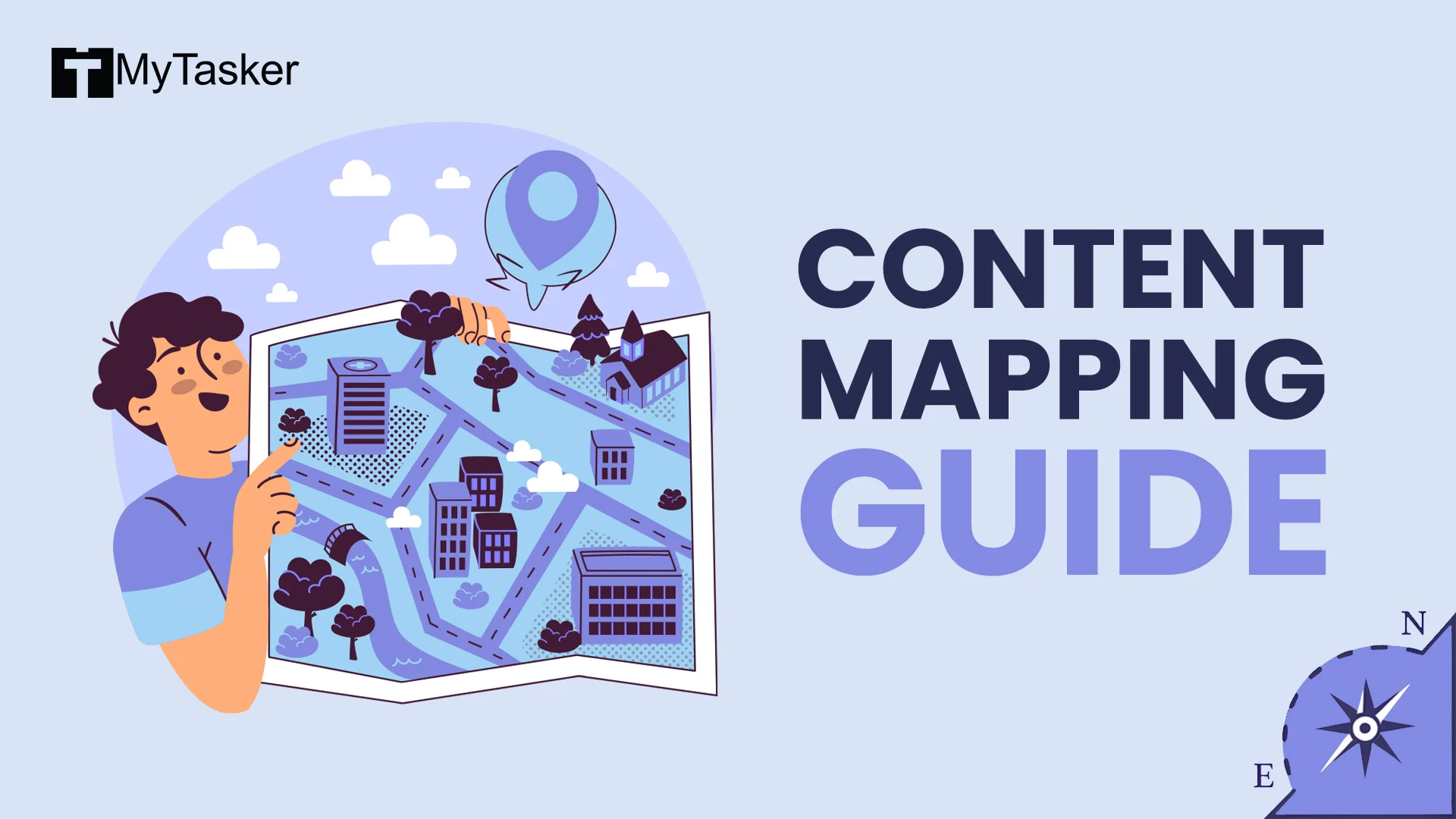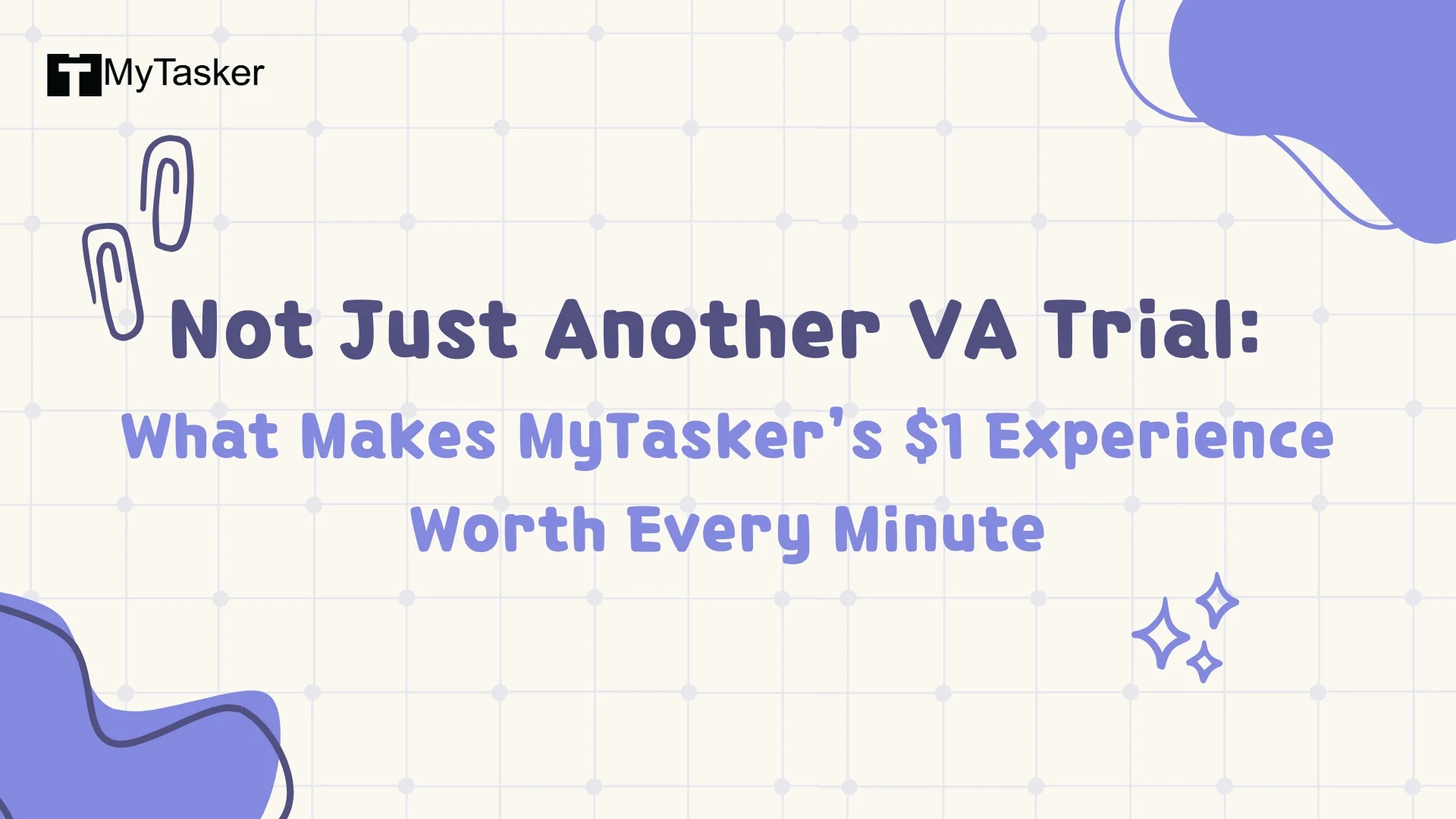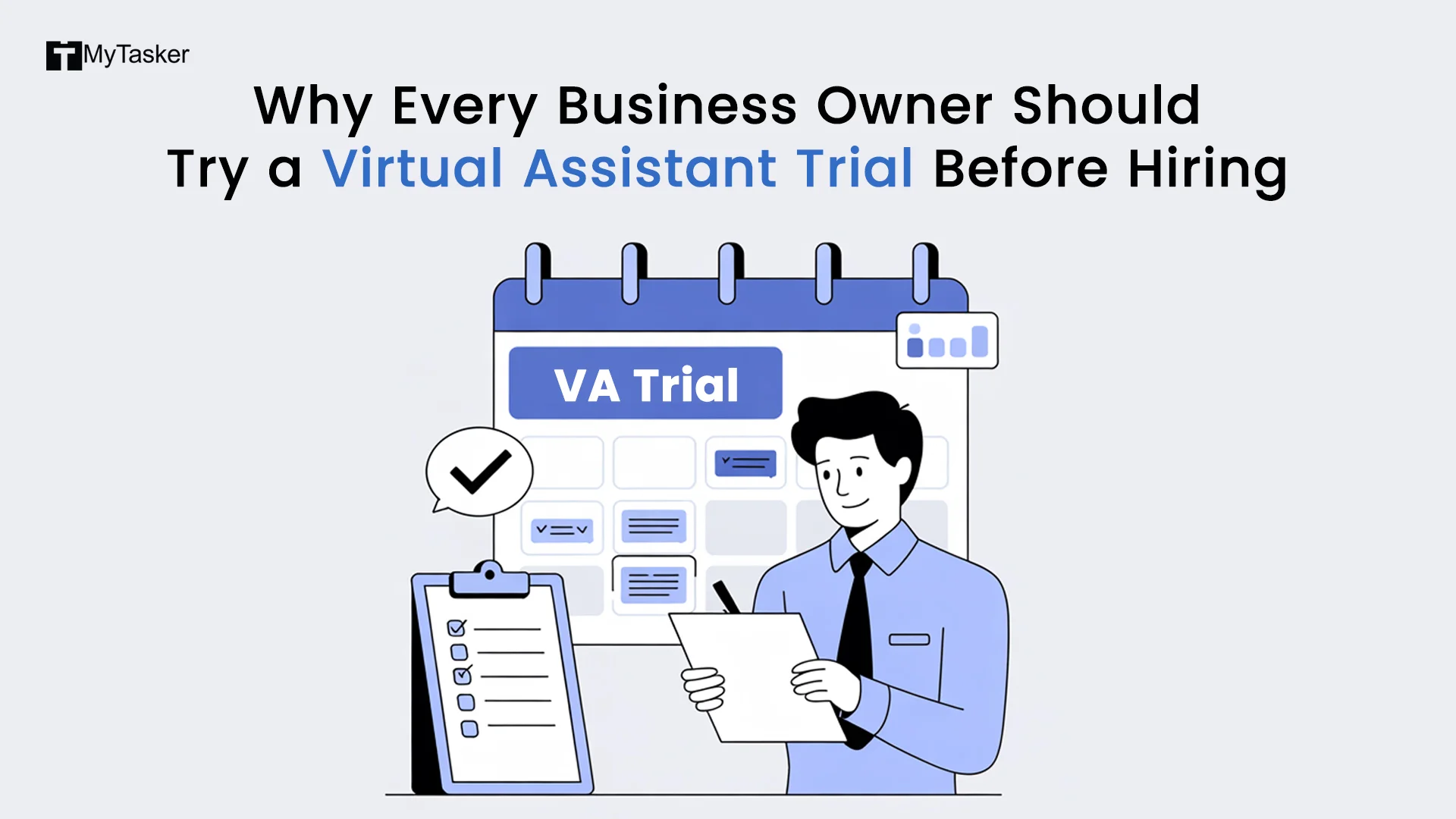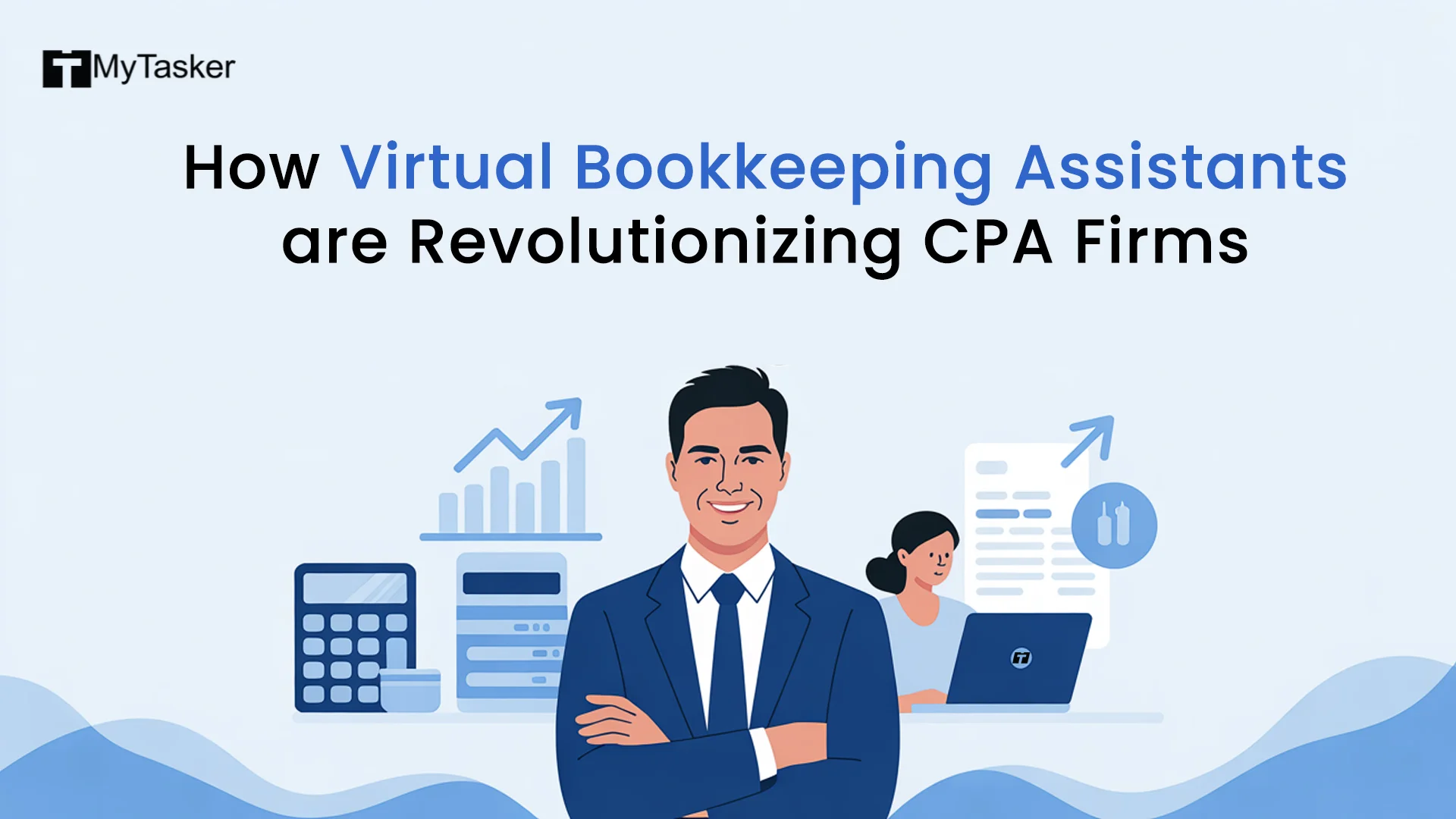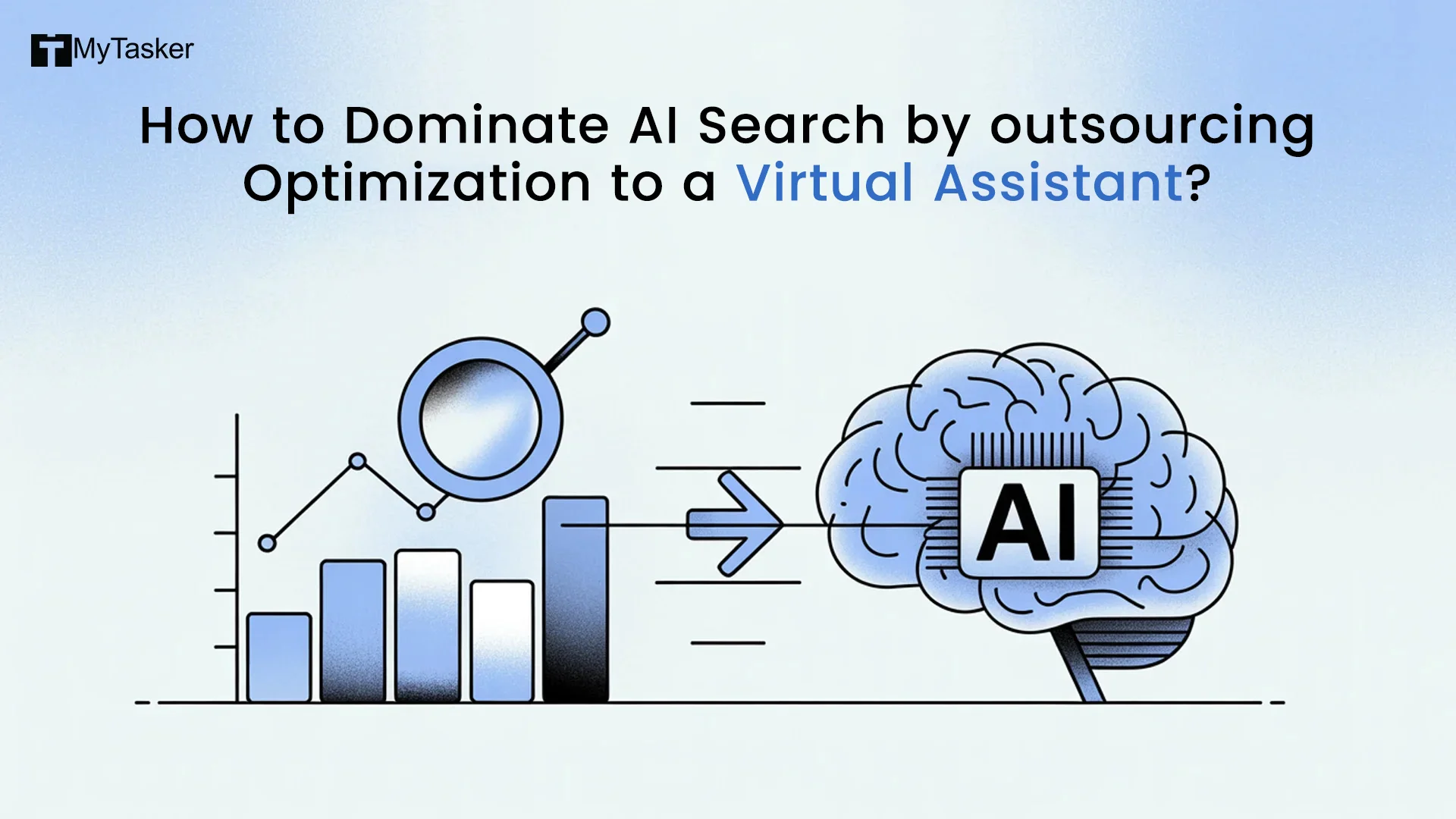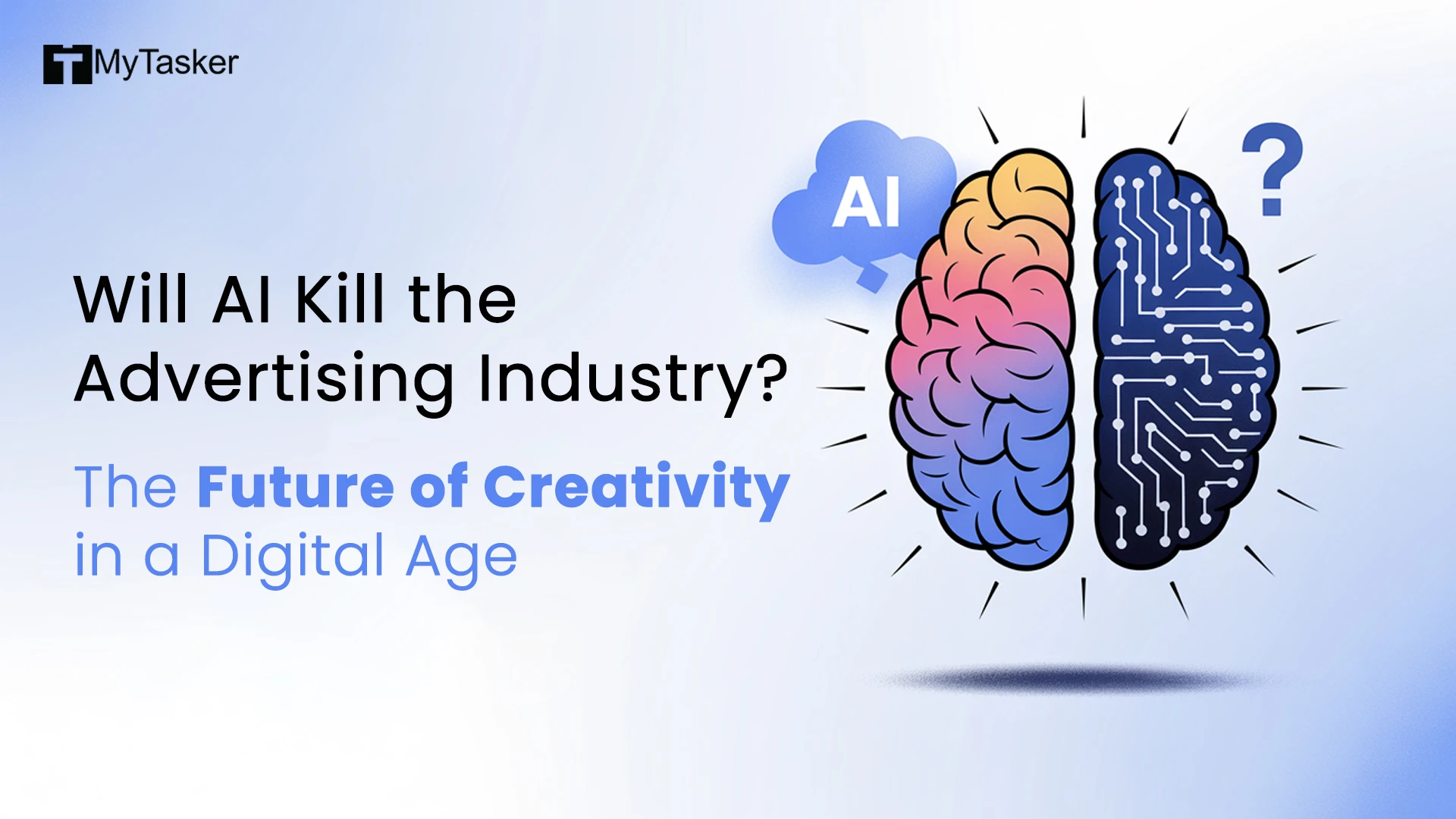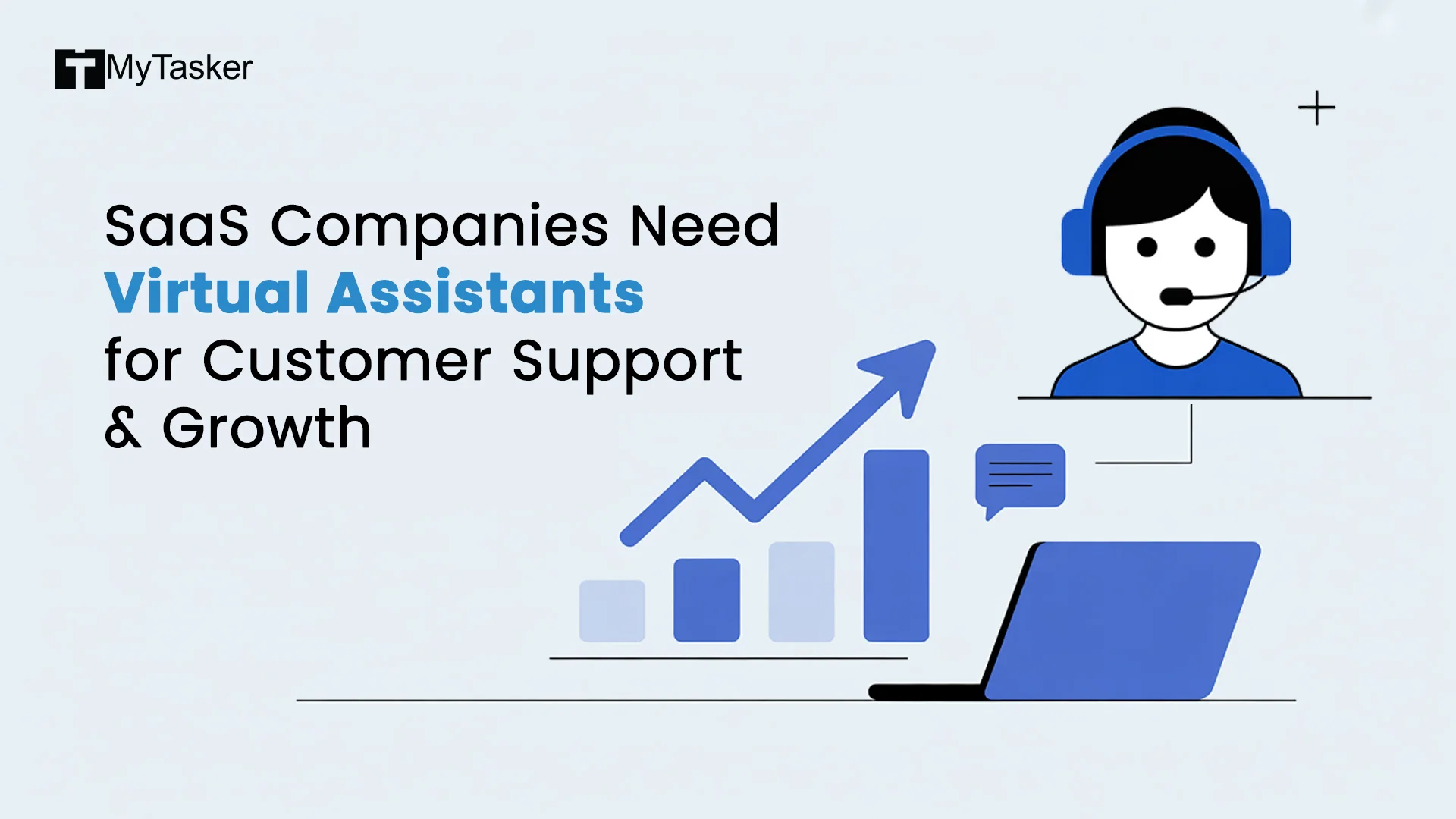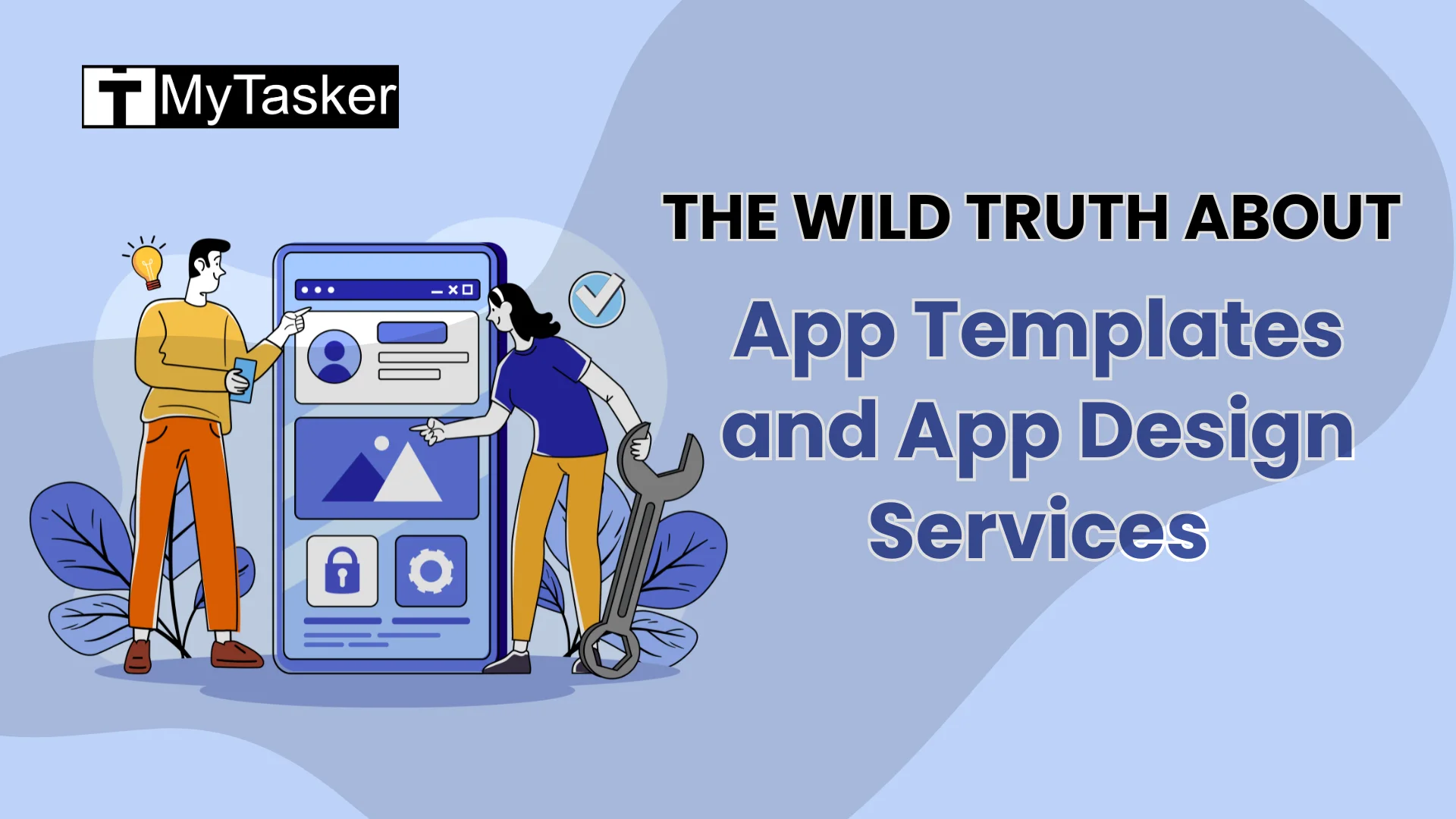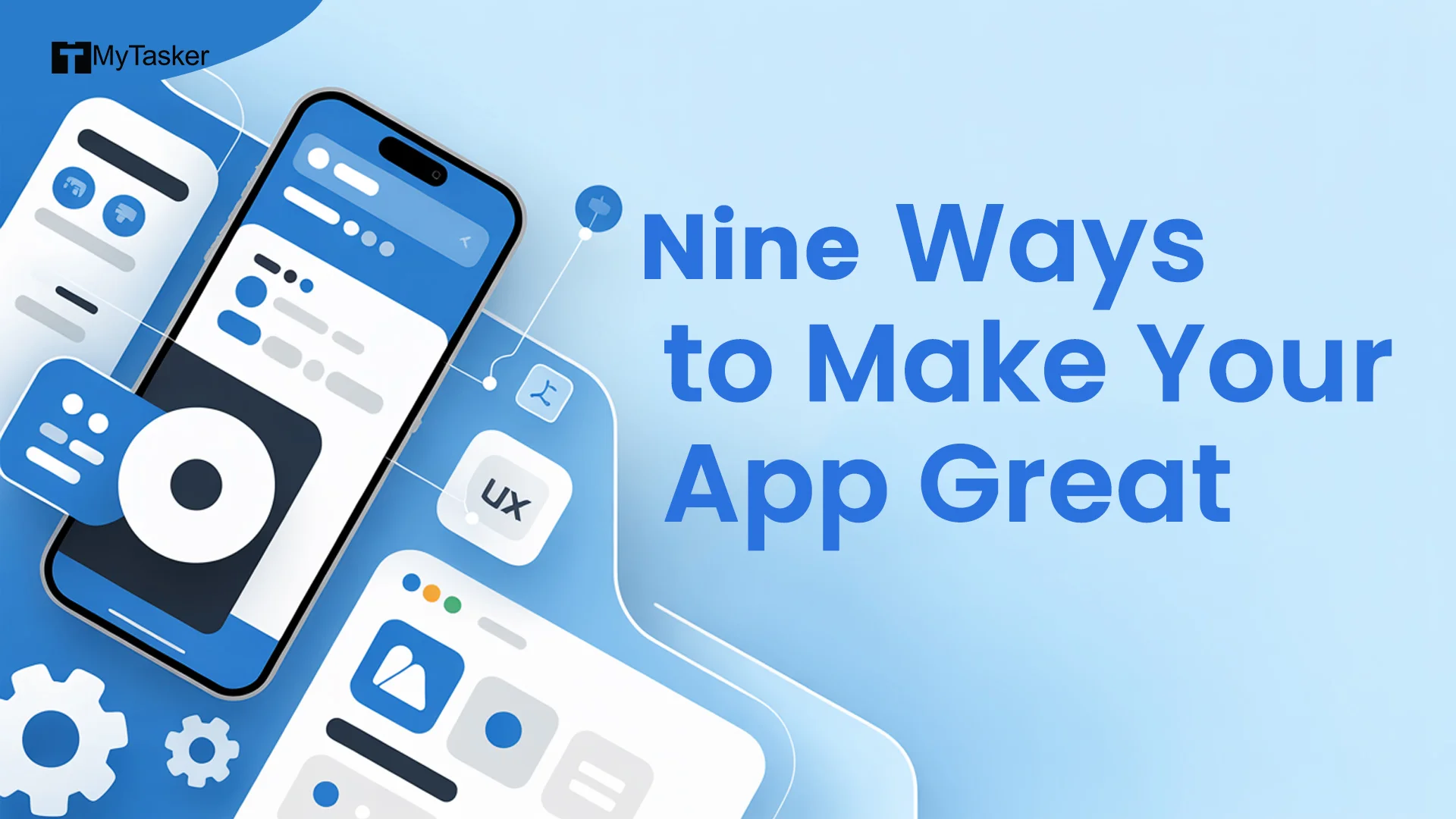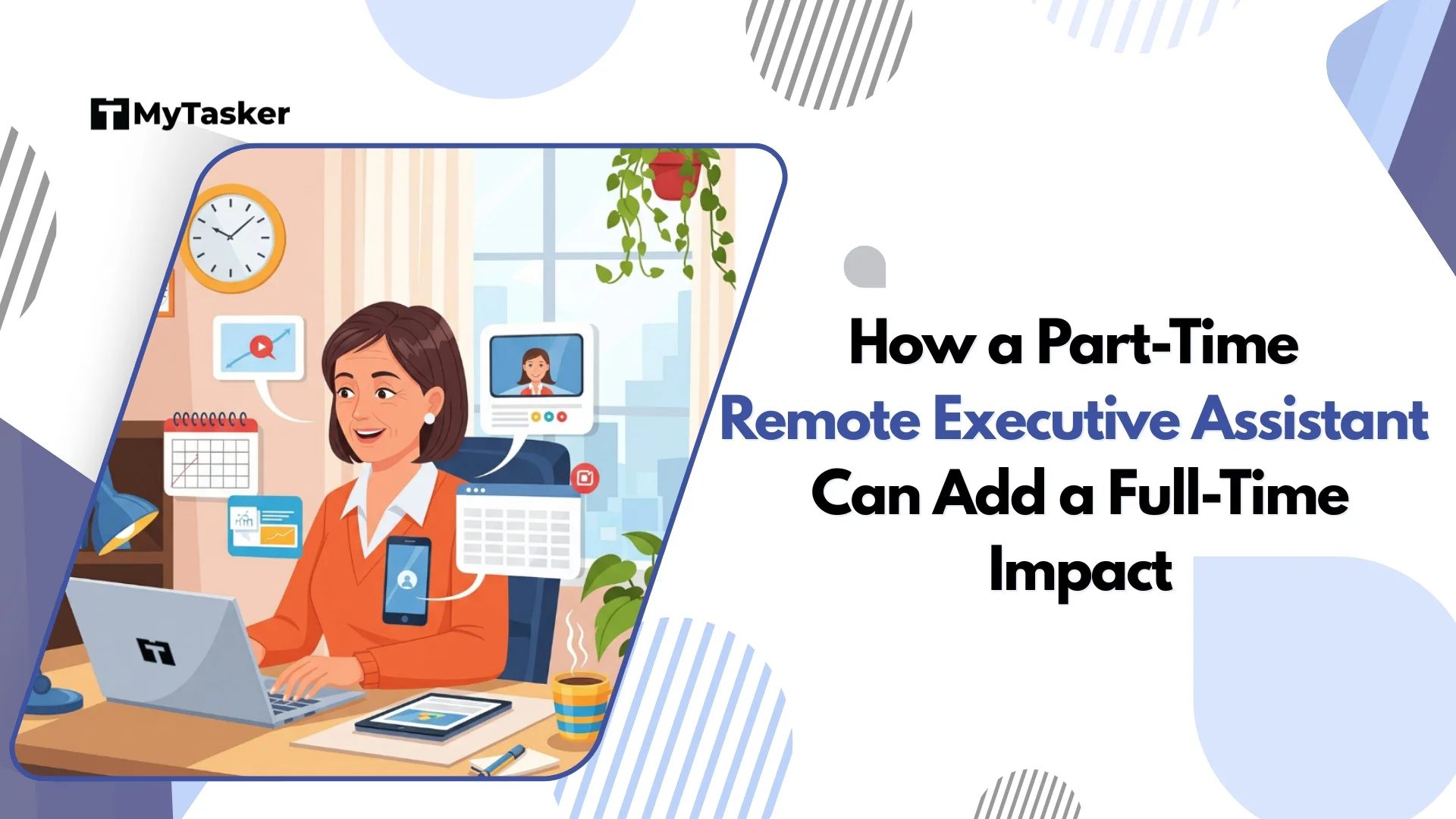Content mapping should drive your website’s overall content marketing strategy. It helps you organize your website's content so that it can speak to your target audience at the right time and through the right channel.
This blog post explores what a content map is, why it is important, how you can create a content mapping strategy for your brand, and some useful tools in the process.
We have also included an example of mapping out content to help you develop your website’s content map. Let us get started with the content mapping process.
A content mapping template is a strategic tool for organizing and visualizing marketing content based on specific goals and audience segments.
Understanding Your Target Audience
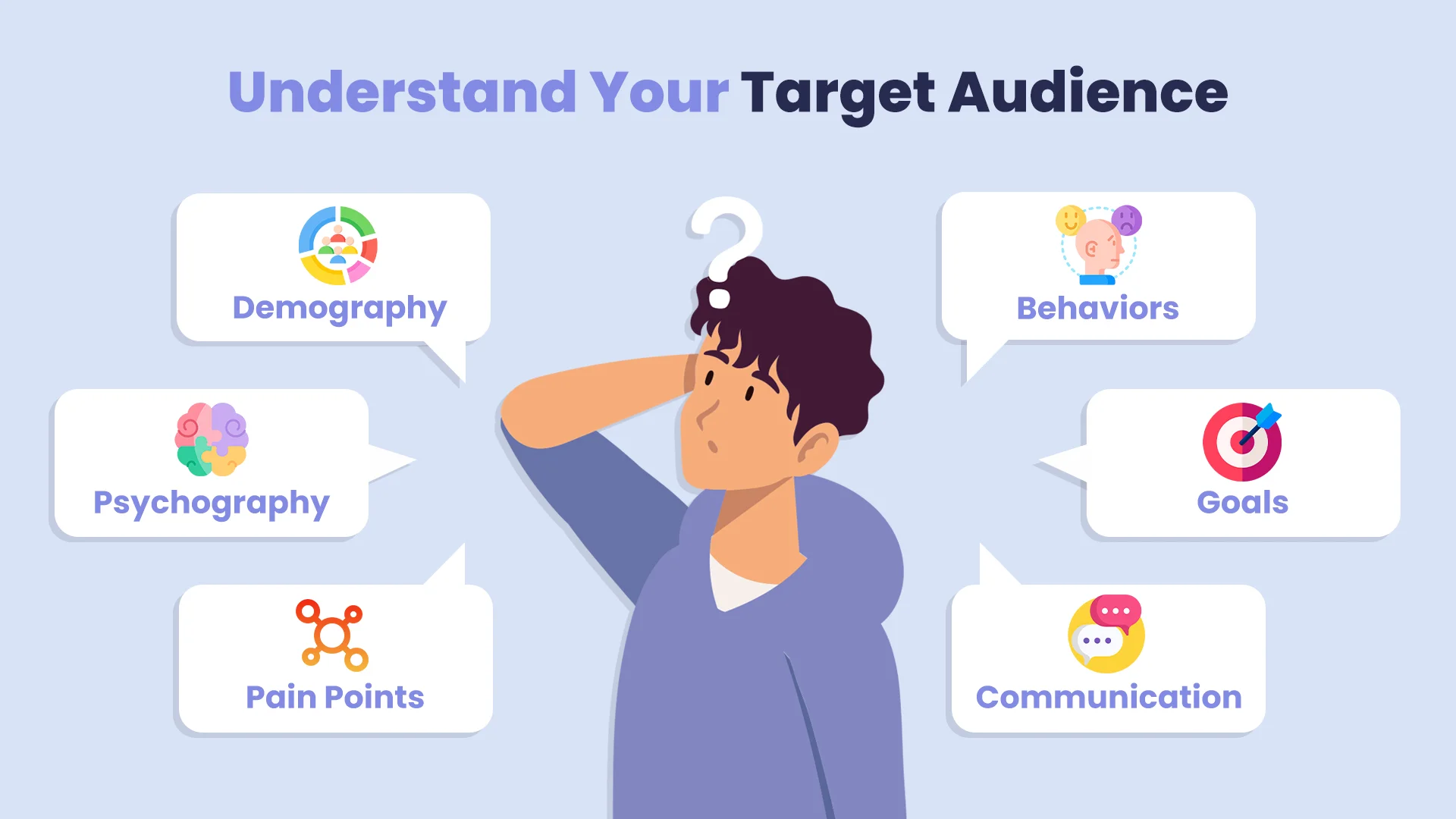
Understanding your target audience through audience segmentation is crucial for creating a successful content map. Your target audience is the people most likely to be interested in your product or service. To make a content map that resonates with them, you need to deeply understand their needs, preferences, behaviors, and pain points.
Here are some key factors to consider when understanding your target audience:
-
Demographics: Consider your audience's age, gender, location, income level, and education level. These basic details can help you tailor your content to be more relatable and relevant.
-
Psychographics: Dive deeper into the interests, values, attitudes, and lifestyle choices of your audience. Understanding these aspects can help you create content that resonates more personally.
-
Pain Points: Identify your audience's biggest challenges and problems. Addressing these pain points in your content can position your brand as a valuable solution.
-
Goals: What are your audience's aspirations and objectives? Knowing their goals can help you create content that aligns with their ambitions and motivates them to engage with your brand.
-
Behaviors: Analyze how your audience behaves both online and offline. This includes their browsing habits, purchasing behavior, and interaction with different types of content.
-
Preferred Communication Channels: Determine which social media platforms your audience frequents and whether they prefer email or phone communication. This information can guide your content distribution strategy.
By understanding these factors, you can create a content map that speaks directly to your target audience’s needs and interests. This ensures that your content is relevant, engaging, and effective in driving business results.
What are the stages of content mapping?
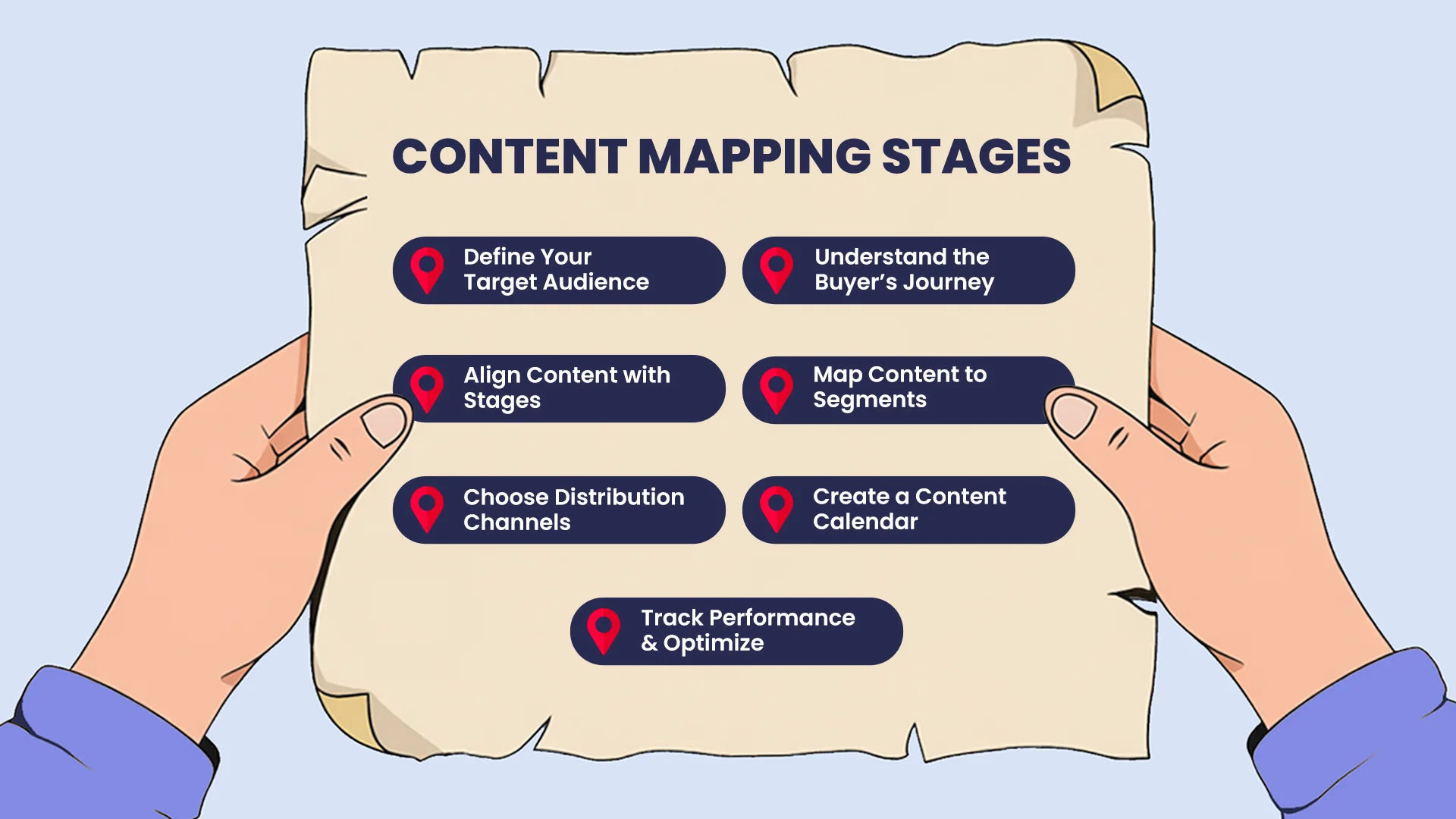
-
Define buyer personas (audience segmentation) following their needs.
-
Map the customer journey to chalk out their awareness, consideration, and decision stages.
-
Align content with these distinct stages to address customers’ needs and questions throughout their journey as part of a comprehensive content mapping strategy.
-
Brainstorm ideas to create relevant content for each stage.
-
Structure topics hierarchically in a content map.
-
Choose formats that suit your audience.
-
Plan and schedule content following an editorial calendar.
What Is Content Mapping?
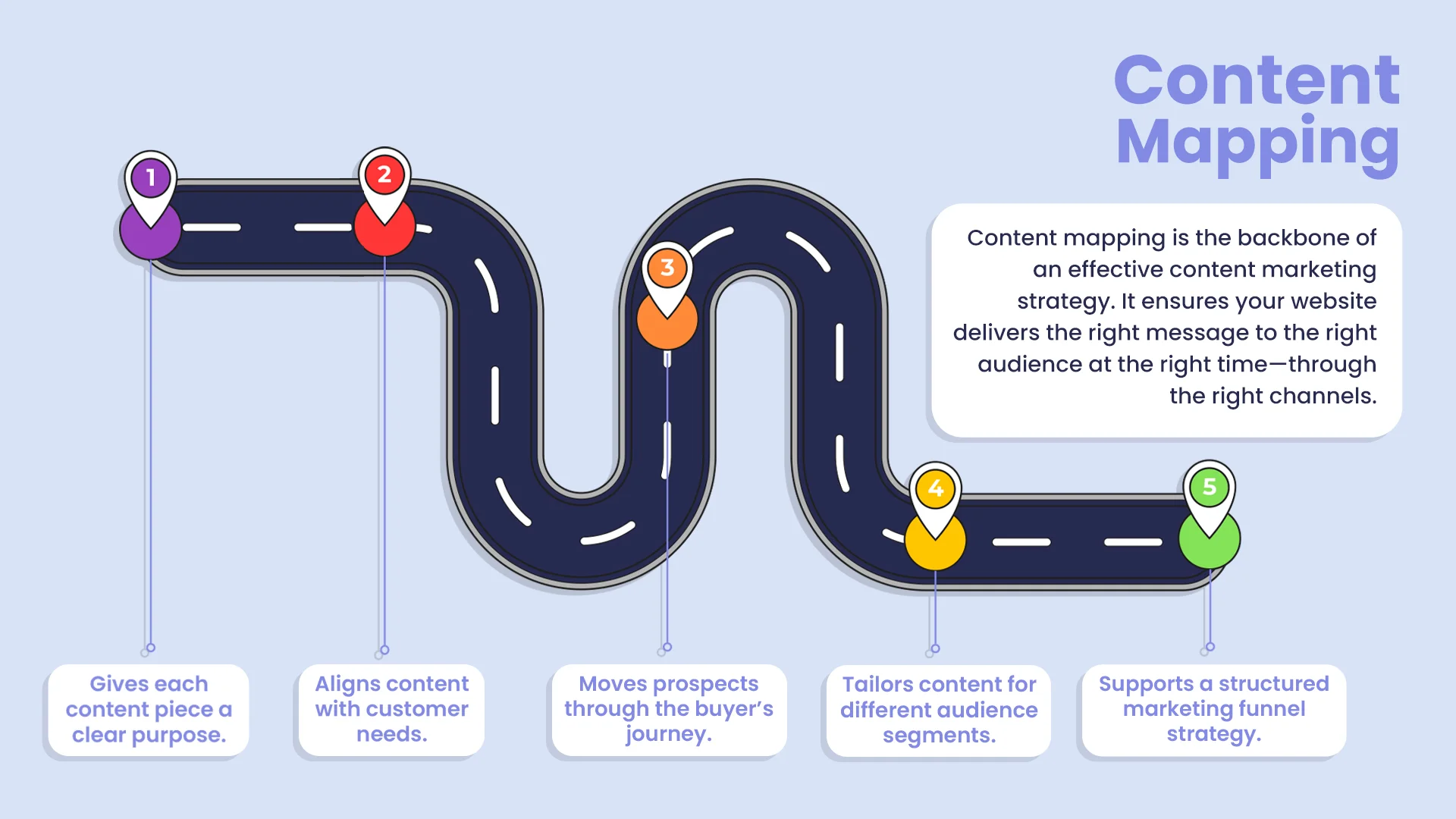
Content mapping is a strategic method of creating informative, valuable, and relevant content for your target audience at different stages of the buyer’s journey. It involves creating a content map using a content mapping template to deliver the right content to the right person at the right time.
A content map is similar to a mind map but is based on a website’s content. It helps you visualize your content and explore different content avenues.
Every piece of content within the content map aims to fulfill the buyer’s needs at a certain point in their lifecycle or journey. This can help you identify and leverage opportunities and gaps in your content strategy. Evaluating and mapping existing content is crucial to identifying content gaps that need to be filled.
Why Is Content Mapping Important?
Every piece of content you create needs to have a purpose. That purpose, in turn, should be tied to your customer’s requirements. Without a clear purpose, the content created would only mean a waste of your time and efforts.
Implementing a content mapping process ensures:
-
Each content piece serves a clear goal or purpose
-
Each content piece is optimized for that goal
-
Each prospect is gradually moving through each step of the buyer’s journey toward purchasing your offering
You need to recognize here that different customers or members of your target audience can have different purposes or goals.
So, a "marketing funnel content mapping" plan helps you deliver diversified content serving different purposes.
How to Create a Content Mapping Strategy
1. Define Your Content Marketing Purpose and Goals
Before developing a content strategy map for your business, you should be clear about your goals first. More specifically, what short-term and long-term goals does your business want to achieve?
How does your content strategy align with those goals? Whom are you trying to help with your business and content strategy, and why?
2. Segment Your Target Audience into Buyer Personas
Knowing and understanding your target audience through audience segmentation determines the actual success of your content mapping strategy.
A buyer persona is a fictional representation of your ideal customer or member of your target audience.
Creating generalized buyer personas makes it easier for you to understand your customers and their behavior. You can create one based on market research, interviews, and customer surveys.
Ask the following questions to gather customer data:
-
Why are they looking for an offering like yours?
-
What goals have your offering helped them to achieve?
-
Why do they buy your products or services instead of your competitors’?
-
What characteristics do they have in common?
Based on the answers to these questions, segment the buyers into different groups having similar answers. Of course, you may end up with two, three, or many more buyer personas, depending on your business.
3. Map Out the Buyer's Journey
A customer journey is the process a buyer follows while making a buying decision. Their thoughts, emotions, and actions prompt them to take each step through their journey.
For example, their journey may start with the idea of wearing the right shoes for sports activities. In this case, they would search for “sports shoes” as the first step in their buying journey.
That is why it is crucial to consider what the buyer may be thinking and feeling behind each of their actions. Accordingly, you can understand which stage of their buying journey they are currently going through.
It typically consists of three primary stages:
Awareness
The buyer, in the awareness stage, realizes a potential opportunity or problem and seeks more information about it.
Consideration
The buyer clearly understands the problem or opportunity and enters the consideration stage, actively researching possible solutions. They may even be comparing different solution providers in this stage.
Purchase or Decision
The buyer identifies the solution and looks for a solution provider to seal the deal during the decision stage. This is the stage where they decide to go ahead with the best solution provider that can meet all their requirements.
4. Plot Your Marketing Funnel Content Mapping Strategy
The reason why it is so vital to map out your buyer’s journey is that your content needs to align with the marketing funnel. In other words, create and implement content corresponding to each stage of the buyer’s journey.
At the same time, you need to tailor the content to each buyer persona.
Different types of content are effective at different stages of the buyer’s decision. Here is an overview of the common content types for each stage:
Awareness
In this stage, the buyer is likely to have questions as to the problems they might be facing.
Think about the symptoms that may be causing their problem, and what information you can provide to help them identify their problem. These factors are going to be the foundation of your topic ideas for the buyers in this stage.
Common content types in the awareness stage include informational blog posts, eBooks, social media posts, infographics, checklists, and emails.
Design these content pieces to provide enough information to your awareness-stage buyers to make them fully aware of their problems.
Your content should try to move the buyer further ahead in their journey toward the next stage, that is, consideration.
Consideration
The content in this stage should outline how your product or service can potentially solve the buyer's problem. At this point, the buyer may be considering and evaluating plenty of options that they think could solve their problem.
Your job is to help the buyer move on to the next stage in their journey to make a decision and choose the most valuable solution (ideally, yours).
The common types of content in the consideration stage can include emails, how-to guides, whitepapers, case studies, product overviews, webinars, and comparison-related videos.
Purchase or Decision
At this step, your goal is to prompt the buyer to choose your offering over your competitors. They would do so only when they see your brand as superior to those of your competitors.
Now, how can you achieve that goal? By answering the buyer's specific questions and building their trust in your brand.
Content types that can help you do that include customer reviews, testimonials, consultation calls, coupons, and live product demos or free trials.
While preparing content for this stage, think about what sets you apart from your competitors. Are you providing a more affordable solution? Is your offering more popular in the market?
Answering these sorts of questions can help you tailor your content to the decision or purchase stage of the buyer's journey.
5. Research and Develop Content Ideas and Topic Clusters
Considering the buyer persona, the stages in the buyer’s journey, and the different content types, it is time to think about what content to create.
Some avenues that can help you come up with content and topic ideas include:
-
Keyword research
-
Content audits of existing content
-
The common problems your buyers are reporting to your sales team
-
Customer reviews
-
Questions your target audience is asking on social platforms like Reddit
Once you have brainstormed a list of potential topics, filter out the umbrella topics or pillar content topics.
Umbrella topics are those that can shelter a large number of topics and sub-topics under them. For example, “web design” would be an umbrella topic or pillar topic. Under it, topics and sub-topics may include “how to learn web design”, “how to design a website”, “the best web design tips”, “web designing software”, and so on.
The pillar page on web design would simply touch on all of these topics. Meanwhile, these other topics and sub-topics would each contain deeper explanations.
So, the topics and sub-topics make up a content or topic cluster together, connected to the umbrella or pillar page.
In this way, you can gather a long list of content ideas and segment those into topic clusters around pillar pages.
6. Bring the Content Ideas Together in an Editorial Calendar
A content calendar or editorial calendar brings your content ideas to life through content mapping visualization. Not only is it a way to keep everything organized but it also gives everyone a bird’s-eye view of what is going on.
Here are some pointers to include when setting up an editorial calendar:
-
The type of the content
-
The stage in the buyer’s journey and the buyer persona to which the content is mapped
-
The team responsible for the content
-
The deadline for each content piece
-
The status of each content piece, that is, whether it has been written, edited, approved, or published
Such a content mapping visualization process ensures everyone is on the same page. Using a content mapping template helps in organizing and scheduling content publication. It also helps schedule the publishing of the content, whether daily, weekly, monthly, or quarterly.
7. Promote and Repurpose Content
Publishing the content is not the end of the road for your content mapping strategy. You also need to promote and repurpose content through different media formats and channels to reach and attract your target audience.
Promotion and distribution channels may include:
-
Your website
-
Your blog
-
Social media
-
Your email subscription list
-
Advertising
-
Paid influencers
-
Review websites and forums
Keep in mind that the channel you use for promoting your content should be one that the buyer is most likely to use. Also, consider your content promotion budget at this point.
At the same time, take into account the various ways in which you can repurpose the published content.
For example, suppose you have published a blog post. You can reformat that blog post into:
-
A video touching on the topics mentioned in the blog post
-
Several social media posts
-
An infographic or a chart
-
A podcast diving deeper into the blog post
-
A downloadable checklist or ebook
Creating a Content Map
1. Visualizing Your Content Strategy
Visualizing your content strategy is the first step in creating a content strategy map. This involves identifying your target audience, understanding their needs and preferences, and determining the types of content that will resonate with them. A content map is a visual representation of your content strategy, outlining the types of content you will create, the channels you will use to distribute it, and the goals you hope to achieve.
To visualize your content strategy, start by brainstorming a list of topics and themes that are relevant to your target audience. Consider their pain points, interests, and goals, and think about how your content can address these needs.
You can use tools like mind maps or diagrams to help you organize your ideas and create a visual representation of your content strategy. This approach not only helps in structuring your content but also ensures that every piece of content you create is aligned with your overall business objectives.
2. Aligning Content with Buyer Personas
Aligning your content with buyer personas is a crucial step in creating a content map. Buyer personas are fictional representations of your ideal customers, and they help you understand their needs, preferences, and behaviors.
By creating content that is tailored to your buyer personas, you can increase the effectiveness of your content marketing efforts and improve the overall customer experience.
To align your content with buyer personas, start by creating a detailed profile of your ideal customer. This should include demographic information, such as age, location, and job title, as well as psychographic information, such as interests, values, and goals.
Once you have created your buyer persona, you can use this information to develop content that is tailored to their needs and preferences. This ensures that your content is not only relevant but also engaging, helping to build a stronger connection with your audience.
3. Ensuring Consistency Across Channels
Ensuring consistency across channels is an important step in creating a content map. This involves ensuring that your content is consistent in terms of tone, style, and messaging, regardless of the channel or platform you are using. By maintaining consistency across channels, you can create a cohesive brand image and improve the overall customer experience.
To ensure consistency across channels, start by developing a content style guide that outlines the tone, style, and messaging for your brand. This should include guidelines for language, imagery, and formatting, as well as examples of how to apply these guidelines in different contexts.
Once you have developed your content style guide, you can use this to ensure consistency across all of your content channels.
By following these steps, you can create a content map that is tailored to your target audience and helps you achieve your content marketing goals.
Remember to keep your content map up-to-date and adjust it as needed to ensure that it remains relevant and effective.
Organizing and Promoting Your Content
1. Effective Content Organization Strategies
Organizing your content is crucial to ensure that it reaches the right audience at the right time. Here are some effective content organization strategies to consider:
-
Categorize Your Content: Group your content into categories based on topics, themes, or buyer personas. This will help you easily identify gaps in your content and ensure that you have a comprehensive content strategy. By categorizing your content, you can also make it more accessible to your target audience, allowing them to find relevant information quickly.
-
Use a Content Calendar: A content calendar is an invaluable tool for planning, organizing, and scheduling your content in advance. It helps ensure that your content is consistent, relevant, and aligned with your overall content strategy. By mapping out your content creation process, you can avoid last-minute rushes and maintain a steady flow of high-quality content.
-
Tag and Label Your Content: Use tags and labels to categorize your content and make it easily searchable. This will help you quickly identify and retrieve specific content pieces when needed. Proper tagging and labeling also enhance the user experience by enabling your audience to find related content effortlessly.
-
Create a Content Hub: A content hub is a centralized location where you can store and organize all your content. It can be a dedicated section on your website, a blog, or even a social media platform. A well-organized content hub not only makes it easier for your audience to access your content but also strengthens your brand’s authority in your niche.
By implementing these content organization strategies, you can ensure that your content is well-structured, easily accessible, and aligned with your content strategy, ultimately enhancing the overall user experience.
2. Best Practices for Content Promotion
Promoting your content is essential to ensure that it reaches a wider audience and drives engagement. Here are some best practices for content promotion:
-
Social Media Promotion: Share your content on social media platforms to reach a wider audience. Use relevant hashtags, tag influencers, and engage with your followers to increase engagement. Social media posts can amplify your content’s reach and drive traffic back to your website.
-
Email Marketing: Share your content with your email subscribers to keep them informed and engaged. Use email marketing automation tools to personalize and optimize your email campaigns. By delivering relevant content directly to your subscribers’ inboxes, you can nurture relationships and encourage repeat visits.
-
Influencer Outreach: Collaborate with influencers in your industry to promote your content. Choose influencers who have a relevant audience and are aligned with your content strategy. Influencer partnerships can significantly boost your content’s visibility and credibility.
-
Content Repurposing: Repurpose your content into different formats, such as videos, infographics, and podcasts, to reach a wider audience. This not only increases engagement but also extends the lifespan of your content. For example, a blog post can be transformed into a video tutorial, a series of social media posts, or an infographic, each catering to different audience preferences.
By implementing these best practices for content promotion, you can ensure that your content reaches the right audience at the right time and drives engagement. Remember to always keep your target audience in mind and create content that is relevant, informative, and engaging.
What tools are the best for creating a content map
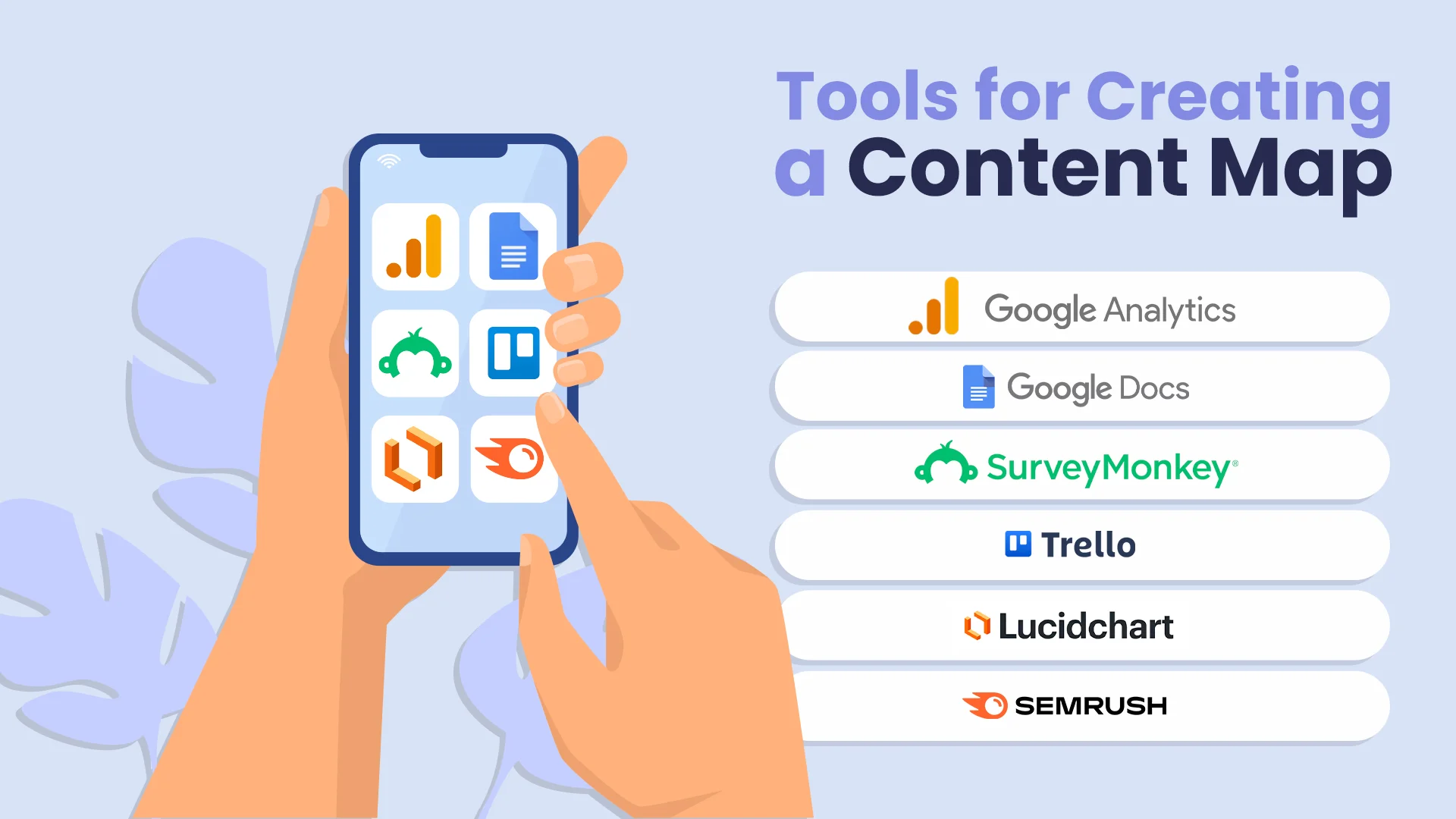
1. Google Analytics
This is popular software that helps you understand what visitors are doing on your website and where they are coming from.
To deliver better results, you need to understand the behavior of your website visitors. Google Analytics lets you do just that, besides tracking and analyzing your audience.
Its Site Search feature, for example, gives you an insight into what visitors are looking for on your website. These insights contribute toward making the necessary changes to improve your website's performance.
Plus, the Audience section provides information about the visitors' demographics, including their age, gender, interests, location, and devices.
For instance, if you notice most of your audience is based in Canada, you can map your content marketing strategy accordingly.
2. SurveyMonkey
SurveyMonkey is a well-known data platform used to conduct customer surveys. Other than creating, editing, and sending out the surveys, you can review the results and discover insights from them.
3. Google Docs
Another popular content mapping tool, Google Docs, lets you insert and draw different types of diagrams. Once you start creating the content map in a Google Doc, you do not have to worry about having a backup, as it is saved automatically.
Secondly, it makes sharing work across your team easier than ever.
4. Trello
Trello is an easy-to-use editorial calendar creation app that allows advanced checklists, activity logs, and a timeline view. It lets you organize your content map using visually attractive boards, cards, and lists.
Teams can also cross-collaborate and arrange cards according to their due dates. Its drag-and-drop style is useful for assigning tasks to your team members and adding files to labels.
5. Lucidchart
You can use this online flowchart tool to create a content strategy map with diagrams, shapes, and lines. The user interface makes adding and arranging items quite simple, so the flowchart creation process is pretty straightforward.
Lucidchart comes with sleek and modern templates that are visually appealing as well. Apart from sporting a wide range of standard shapes, it lets you create and save customized shapes of your own.
You can also export the content map to Microsoft Visio, SVGs, image files, and PDFs. Further, it offers real-time collaboration like Google Docs does.
A Content Mapping Example
Suppose you own a travel agency website that offers tour packages for both national and international destinations. The first step toward designing a content strategy map is to create a buyer persona. Let us name this persona “Julia”.
Julia has always traveled with her friends and family members but has never been on a solo trip before. Now, she wants to go on one, but she is confused about her first solo travel destination.
Simultaneously, she is looking for international destinations where she can travel solo on a budget. So, she resorts to the internet to find a solution to her problems.
This is what her buyer's journey looks like
Awareness stage
She will look for introductory content that can help her learn more about solo traveling. She will also search for possible international destinations she can travel alone to.
Consideration stage
After gaining an idea about solo traveling and zeroing in on a cheap destination, she will want to create a clear budget for her journey.
In this stage, she is likely to seek a how-to guide that will teach her how to set up a budget. A downloadable template for budgeting can also come in handy for her at this point.
At the same time, she will be inspired by another first-time solo traveler who has already bought your tour package.
Purchase or decision stage
Now that Julia has identified her needs, she wants to fulfill them by looking for the best solution provider (or tour package, in this case).
She will request quotes or consults from your travel agency since you have guided her toward your cost-effective international tour packages.
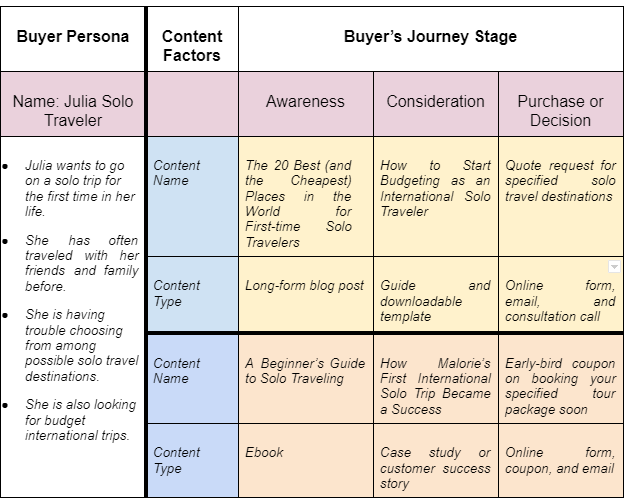
Content Gaps and How to Find Them
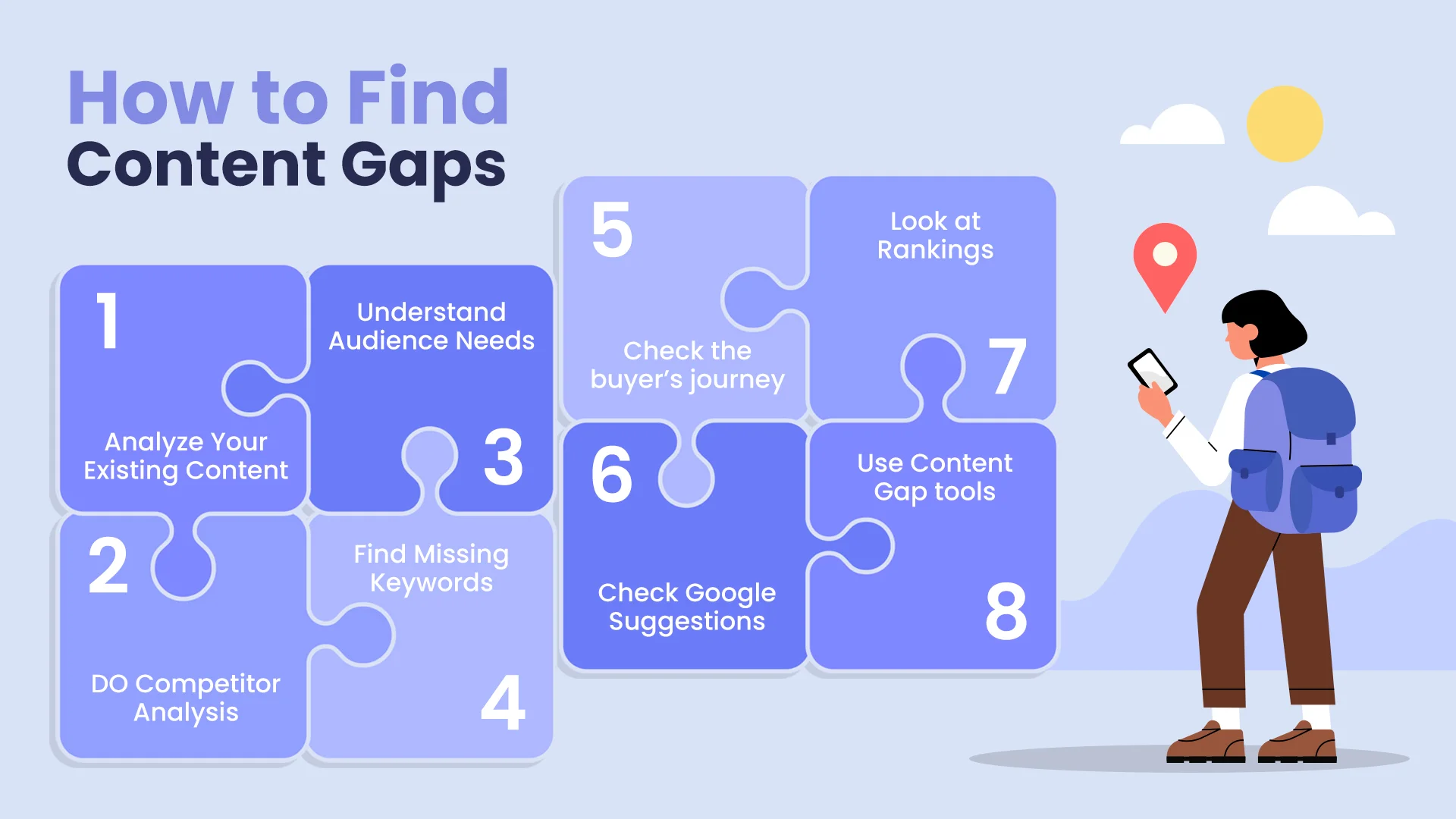
What is a Content Gap?
A content gap is the difference between what your audience needs and what you currently have. It shows where potential customers are looking for information but can’t find it on your website or content platforms. By identifying these gaps, you can create targeted content that meets your audience’s needs and drives engagement and conversions.
How to Find Content Gaps
-
Analyze Audience Questions: Use tools like Answer the Public or BuzzSumo to find questions related to your industry. These tools analyze search data to show what users are searching for so you can spot missing topics in your content strategy.
-
Keyword Research: Use keyword research tools like UberSuggest or Google Search Console. These tools will show you which keywords are getting traffic but have no content on your site, so you know there’s a gap.
-
Competitor Content: Analyze competitors’ websites to see what topics they cover that you don’t. Tools like SEMrush or Ahrefs can show you their high-performing content so you can spot opportunities for your content.
-
Engage with Your Audience: Monitor forums, social media, and community discussions to see what’s trending and what’s unanswered. Direct engagement can reveal big gaps in your current offerings.
How often should I update my content map?
Updating your content map is essential to keep it relevant and effective. How often you update will depend on:
-
Annual Audits: Do a full content audit at least once a year. This will help you identify outdated content and areas for improvement, especially for bigger or more dynamic websites.
-
Content Performance: Monitor your existing content’s performance using metrics like traffic, engagement, and conversions. If some pieces are underperforming or if big changes happen in your industry, update those more frequently.
-
Type of Content: Different types of content have different lifespans. Evergreen content may need annual updates, while trending topics may need more frequent updates to stay current.
-
Rolling Updates: Do a rolling audit where you review sections of your content map rather than all at once. This makes the process more manageable and ensures continuous improvement.
-
Content Calendar: Use a content calendar to schedule updates based on your marketing campaigns and resource availability. This will keep the flow of fresh content going.
While an annual review is a good baseline, the frequency of updates should be based on your content and audience engagement levels. Monitor and adjust based on performance to keep your content map effective.
How does content mapping improve user engagement on my site?
-
Personalization: Content mapping matches content to the user’s stage in their journey, so they get more relevant content. This addresses their needs and builds trust.
-
More Relevance: By creating content for each stage (awareness, consideration, decision) you ensure users get the right info at the right time, reducing bounce rates and increasing time on site.
-
Better User Experience: Content mapping makes navigation through the buyer’s journey smoother. Users find helpful content easier, which improves their overall experience and interactions.
-
Guiding Conversions: When content matches user intent it naturally guides them to conversions – whether that’s filling out a form, subscribing or buying.
-
Better SEO: Mapping content to stages and targeting keywords improves your search engine rankings, attracting more visitors who are likely to engage with your content.
-
Consistency Across Channels: A mapped strategy means your messaging is consistent across all touchpoints (social, email, blog) and builds engagement and brand loyalty.
More user interactions. More engagement. More conversions.Boom!
What are some common pitfalls to avoid when creating a content map?
When creating a content map, several things can go wrong.
Common Pitfalls to Avoid
No Clear Objectives
Without specific goals, content mapping gets disorganized and out of sync with business objectives. Define clear, measurable goals.
Ignoring the Buyer's Journey
Failing to consider the buyer's journey means content misses audience needs. Create content for awareness, consideration, and decision-making stages.
Overcomplicating the Structure
A complex content map confuses both your team and the audience. Keep it simple and clear.
Not Doing Audience Research
Without research, your content won't resonate with your target audience. Know audience preferences, pain points, and behaviors for effective mapping.
Not Updating Regularly
Content maps need to evolve with your business and audience. Update regularly to avoid outdated content and stay aligned with market changes.
Limited Content Types and Formats
Relying on one or two content formats can't engage all audience segments. Use a mix of formats like videos, infographics and blogs.
Not Measuring Performance
Not tracking content performance means you can't measure effectiveness. Use analytics to track engagement and conversion rates and adjust based on data.
Content Mapping Tips From the Pros
-
Be Clear: Define measurable goals that align with business outcomes.
-
Know Your Personas: Deep dive into audience behavior and pain points for personalization.
-
Focus on Journey Stages: Content for awareness, consideration, and decision phases.
-
Mix It Up: Use different formats (blog posts, videos, infographics) for different segments.
-
Keep it Simple: Don’t overcomplicate the map; clarity is key for your team and audience to understand.
-
Update Often: Refine the map as the audience and market evolves.
-
Measure: Use analytics to measure content and improve engagement and conversions.
-
Integrate SEO: Content aligns with SEO strategies to improve search ranking and visibility.
As you can see, asking and answering the right questions is key to creating content that drives results. Content does not have to be a guessing game anymore with a content mapping plan in place.
However, you may need to focus more on the core areas of your business than on designing a content map. If this is the case, you can reach out to the Digital Marketing Experts at MyTasker.
By mapping out a smart content strategy for your business, they can create the exact content your target audience needs from you. This can help improve your chances of winning loyal customers.
Conclusion
Creating a content map is crucial in developing a successful content marketing strategy. By understanding your target audience, creating a content map, and using the right tools and templates, you can ensure that your content is relevant, engaging, and effective in driving business results.
Remember, a content map is not a one-time task but an ongoing process that requires regular review and updates. Your content map should reflect these changes as your business and target audience evolve.
Following the steps outlined in this guide, you can create a content map that helps you achieve your business goals and drives real results. Whether you’re a small business or a large enterprise, a content map is an essential tool for any content marketing strategy.
With a well-structured content map, you can streamline your content creation process, ensure consistency across all channels, and, ultimately, build stronger connections with your target audience. So, start mapping out your content today and watch your content marketing efforts soar to new heights!



